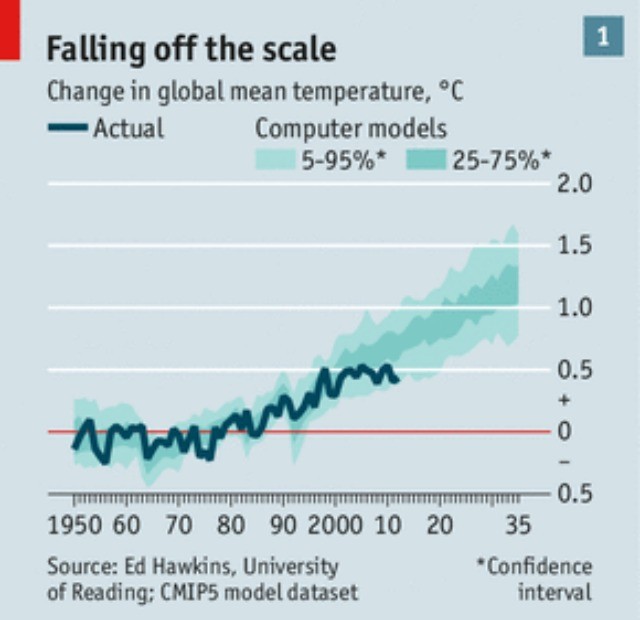
There’s a new consensus forming that the worst forecasts for global climate change may need to be reconsidered. The clearest sign of this is a piece that appeared in the Economist March 30th titled “A Sensitive Matter.”
The title of the piece has a double meaning. It’s a reference to climate sensitivity to carbon dioxide but also to the political climate which, in the last five years, has taken to calling anyone who dares to disagree with climate predictions “deniers.”
But the Economist, which has a history of pushing dire predictions about climate change, has decided to broach the sensitive topic and point out actual surface temperatures have already exited the 75 percent confidence interval predicted by climate models and now seems on course to exit the 95 percent interval in just a couple more years.
That could still change of course, but for the moment it looks like the models have predicted more warming than is actually taking place. There are of course different possible explanations for this. It’s possible that aerosols are more reflective than previously thought, meaning more of the sun’s energy is being reflected rather than absorbed. At the same time, it’s possible that the warming effect of one aerosol, soot, has been underestimated by climate models.
The Economist points out that there are new papers being published using alternative models which predict a significantly lower temperature increase. The article highlights several of these including the work of Nic Lewis who “reanalysed work cited by the IPCC and took account of more recent temperature data.” Lewis concluded the actual temperature increase would more likely be around 1.6 degrees Celsius. That’s half the increase predicted by the IPCC.

The policy impact comes not at the end of the piece but in the middle. It’s the kind of common sense that should appeal to conservatives turned off by climate change fear-mongering:
If, as conventional wisdom has it, global temperatures could rise by3°C or more in response to a doubling of emissions, then the correctresponse would be the one to which most of the world pays lip service:rein in the warming and the greenhouse gases causing it. This is calledpossibility of something catastrophic, such as a 6°C rise, that couldjustify drastic interventions. This would be similar to taking outdisaster insurance. It may seem an unnecessary expense when you areforking out for the premiums, but when you need it, you really need it.Many economists, including William Nordhaus of Yale University, havemade this case.
If, however, temperatures are likely to rise by only 2°C in responseto a doubling of carbon emissions (and if the likelihood of a 6°Cincrease is trivial), the calculation might change. Perhaps the worldshould seek to adjust to (rather than stop) the greenhouse-gas splurge.There is no point buying earthquake insurance if you do not live in anearthquake zone. In this case more adaptation rather than moremitigation might be the right policy at the margin.
The important point is that we just don’t know enough at this moment to say which response–mitigation, drastic intervention or adaptation, is appropriate. The growing divergence between models and reality means the consensus–like the models–may need some adjustment.

COMMENTS
Please let us know if you're having issues with commenting.